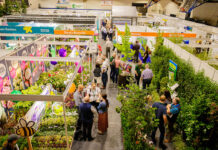Phasing-out the use of peat is a near perfect green policy with multiple benefits but governments and Europe have failed to act.
We’ve finally got round to buying the bedding plants. So this afternoon I’ll be ripping out the early-season pansies and planting pink geraniums, chosen this year by my better half after complaints about colour co-ordination with the rest of the garden when I chose them last year. The only blot on the landscape is a large bag of compost marked “peat reduced formula” sitting unopened on the gravel. Now I know that the garden centre thought it was doing the right thing but why, I asked, does potting compost need to contain peat at all?
Call me awkward, but I happen to know this stuff forms naturally at a ridiculously slow rate (1mm a year), so the use of more than a thimbleful of it is unsustainable. Peat extraction in this country destroys wildlife habitats and, as the dried-out peat oxidises, vents into the atmosphere each year the amount of carbon dioxide emitted by 100,000 cars. That’s excluding the emissions we cause in countries such as Ireland, from which we import most of our peat.
The use of peat is one of those environmental problems everyone thinks we have solved – until they read what it says on the sack. To their credit, the authors of last week’s natural environment white paper for England were right to recognise that stopping peat use is near the top of the list of the things you should be doing if you want to arrest the decline of habitats and species and to cut greenhouse gas emissions, not to mention to move closer to a “zero waste” economy by composting all food and green waste. A phasing-out of peat is almost the perfect green policy. The proposed solution of this “greenest government ever” is a voluntary phasing-out of peat in gardens by 2020.
It is a disgrace that England’s gardeners and horticultural businesses still use nearly 3m tons of peat a year. A fuss was made about peat extraction on protected British wildlife sites in the 1990s, a form of destruction that has now mercifully largely ceased, though workings on unprotected bogs continue. It is even worse that so few of us feel a twinge of guilt each time we buy a pot plant, a tomato or a lettuce from the supermarket. We should feel even more concerned now the role of peat bogs as carbon stores is better understood.
Few of us feel a twinge of guilt each time we buy a pot plant, a tomato or a lettuce Ah, you say, but aren’t there perfectly good substitutes for peat made from coir, bark and composted green waste for nearly all horticultural purposes? So what’s the problem? The most obscure things, such as our one wild carnivorous plant, the sundew, will grow only in peat. Some countries, such as Australia, don’t have peat and have wonderful gardens. So did Britain before the 1970s, when we used something called loam. Why wait until 2020 for amateur gardeners to give up peat – and 2030 for horticulture? Compared with the development times of, for instance, Apple’s iPad, the gearing-up period necessary to replace peat with compost sounds positively Neolithic.
Behind this long and unambitious timetable lies a cautionary tale, the sorriest part of which is that ministers undertook more than a decade ago to phase out 90% of our use of peat by the end of 2010. This was one of those green promises made in the Blair/Brown/Prescott years that were either unrealistic or simply forgotten by ministers and civil servants. (Other daft promises that will have to go include Europe’s unachievable 2020 renewables target and Gordon Brown’s bizarre promise that all cars sold in Britain would be hybrids or electric by the same year.) Despite excellent progress in phasing out peat in the early 2000s – partly thanks to Alan Knight, then at B&Q and now head of the government’s new peat taskforce – the amount of alternatives to peat used in compost then reached a ceiling. Now the proportion of the market that is peat-free languishes at 58%. A number of things appear to have gone wrong. The first is that many gardeners still prefer peat and aren’t fully aware of the environmental consequences of digging it up. Their number includes famous figures such as Alan Titchmarsh, the front man of BBC nature programmes, who really should know better.
Clearly to blame are horticultural firms that own peat bogs and have no incentive to invest in anything else. But the biggest excuse for inaction is that Europe has no strategy for minimising the use of peat and so if a tax on peat were imposed here – not part of government plans at present, but I predict it will be if its modest targets are to be met – our horticultural products would be undercut by exports from countries where governments aren’t doing anything. This is a real international problem and our civil servants and permanent representatives in Brussels seem to have done almost nothing about it for more than a decade. Green policy over long timescales is not something we do well.
So it was all very well for Lord Turnbull, the former head of the civil service, to have a go at ministers last week for signing up to unachievable climate change targets and green energy policies that would damage the economy, instead of pursuing sensible, “no regrets” measures with multiple benefits. Getting rid of peat would be just such a sensible measure, but the permanent government he headed, while ministers came and went, failed to deliver. Motes and beams, Turnbull. Motes and beams.
Source: The Sunday Times – A Green Dream Smothered by Gardeners’ Peat







